|
[CHIMIE] - LAMIRAND, PARISELLE -
COURS DE CHIMIE ORGANIQUE tome 3.
Paris, MASSON ET CIE , 1938; in-8, 746 pp., broché, couverture illustr. Legerement debroché volume seul.
Bookseller reference : 200615140
|
|
|
[CHIMIE] - MAYOR (Y) -
La grande industrie chimique organique.
Paris, Gauthier-villars, 1941; in-8, 250 pp., broché, couverture illustr.
Bookseller reference : 200615135
|
|
|
[CHIMIE] - BRUN (E), JOCKEY (E) -
Cours de chimie générale.
Paris, Gauthier-villars, 1940; in-8, 342 pp., broché, couverture illustr.
Bookseller reference : 200615126
|
|
|
[CHIMIE] - DUPONT (G) -
Cours de chimie industrielle en 5 volumes.
Paris, Gauthier-villars, 1936; in-8, 185-336-357-250-279 pp., broché, couverture illustr. Les 5 volumes. Généralités - les combustibles-les industriees minerales-métallurgie-industries organiques.
Bookseller reference : 200615123
|
|
|
[CHIMIE] - TROOST (L.) -
Traité de chimie élémentaire.
Paris, G. Masson Editeur, 1877; in-8, 876 pp., cartonnage d'éditeur avec jaquette. Etat médiocre, tranche coupée.
Bookseller reference : 200613589
|
|
|
[CHIMIE] - SCHMIDT (J.) -
Traité de chimie organique.
Paris, Albin Michel, 1928; grand in-8, 922 pp., broché. Tranche usuurée à la fin de l'ouvrage.
Bookseller reference : 200613501
|
|
|
[CHIMIE]
Cours de chimie ecoles primaires supérieures brevet élémentaire.
Paris, Librairie Générale, s.d.; grand in-8, 396 pp., cartonnage de l'éditeur. Programme de 1920.
Bookseller reference : 200613279
|
|
|
[CHIMIE] - MEURICE (Raoul) -
Précis de chimie analytique.
Gembloux, Imprimerie J. Duculot, Libraire-Editeur, 1929; grand in-8, 160 pp., broché. Deuxieme edition, tranche abimée.
Bookseller reference : 200613278
|
|
|
[CHIMIE] - MARTINET (J.) -
Précis de chimie d'après les théories modernes.
Paris, Gaston Doin & Cie, 1934; in-8, 934 pp., cartonnage de l'éditeur.
Bookseller reference : 200613275
|
|
|
[CHIMIE] - MASSOULIER (P.) -
Chimie classe de première.
Paris, Librairie Vuibert, 1939; in-8, 131 pp., cartonnage de l'éditeur.
Bookseller reference : 200613271
|
|
|
[CHIMIE, MATHEMATIQUES] - CHATELET (A.) -
Chimie classe de mathématiques.
Paris, Editions J.-B. Baillière & Fils, s.d.; in-8, 194 pp., cartonnage de l'éditeur. Quelques pages arrachées.
Bookseller reference : 200613270
|
|
|
[CHIMIE] - TRAVERS (A.) -
Leçons de chimie à l'usafe des élèves de mathématiques spéciales et des étudiants des facultés des sciences I. Chimie générale.
Paris, Librairie Vuibert, 1931; grand in-8, 176 pp., broché.
Bookseller reference : 200613263
|
|
|
[CHIMIE] - JANOT (Maurice-Marie) -
L'épée d'académicien de MAURICE-MARIE JANOT.
Paris, Librairie Masson, 1970; in-8, 80 pp., broché. Allocutions prononcées le 28 février 1969 à la maison de la chimie - dédicace ?
Bookseller reference : 200604069
|
|
|
[CHIMIE] - REYBAUD (Louis) -
Le fer et la houille Etudes sur le régime des manufactures " A l'écoute du peuple".
Brionne, Gérard Montfort, 1977; in-8, 384 pp., broché, couverture illustr.
Bookseller reference : 200510147
|
|
|
[CHIMIE] - [REGNAULT (M.V.)] -
Cours élémentaire DE CHIMIE à l'usage des facultés, des établissements d'enseignement secondaire, des écoles normales et des écoles industrielles.
Paris, L. Langlois 10 rue des Mathurins, 1959; in-12, 428-414-466-582 pp., cartonnage de l'éditeur. Les 4 volumes. En 4 volumes, demi-cuir à caissons.
Bookseller reference : 200509427
|
|
|
[CHIMIE] - TRAVERS (A) -
Leçons de chimie.
Paris, Librairie Vuibert, 1951; in-8, 210 pp., broché. Tome 1 - chimie générale - a l'usage des élèves de mathématiques supérieures et de mathématique spéciales.
Bookseller reference : 200509367
|
|
|
[CHIMIE] - LAVOLLAY (JEAN) -
LA CHIMIE DES ÊTRES VIVANTS.
Paris, PUF, 1980; in-12, 128 pp., br.
Bookseller reference : 200404278
|
|
|
[CHIMIE] - THENARD (L.J.) -
Traité DE CHIMIE élémentaire, théorique et pratique.
A Paris, Chez Crochard, Libraire, Cloître St.-Benoît, n° 16, 1821; in-8, 741-758-788-450-33 planches, cartonnage de l'éditeur. Les 4 volumes. Troisième édition, revue et corrigée (exemplaire piqué) demi-veau(etiquettes titre et tomaison abimé, fendues).
Bookseller reference : 200403640
|
|
|
[CHIMIE] - FORBIN (Victor) -
Le pétrole dans le monde.
Paris, Payot, 1940; in-8, 234 pp., br.
Bookseller reference : 200401697
|
|
|
[MACQUER]
Dictionnaire de Chymie, contenant la Théorie et la Pratique de cette Science, son application à la Physique, à l'Histoire Naturelle, à la Médecine et à l'Economie animale; avec l'Explication détaillée de la Vertu et de la manière d'agir des Médicamens Chymiques. Et les Principes fondamentaux des Arts, Manufactures et Métiers dépendans de la Chymie. [CHIMIE]
Paris, Lacombe, 1769. 2 Volumes, complet. In-8 - 11,5 x 18cm Reliure pleine basane d'époque.
Bookseller reference : 1

|
|
|
DERIBERE, Maurice.
Les Applications industrielles du pH.
Paris Dunod 1946 In-8 - 15,5x24cm. Broché. 367pp
Bookseller reference : 180
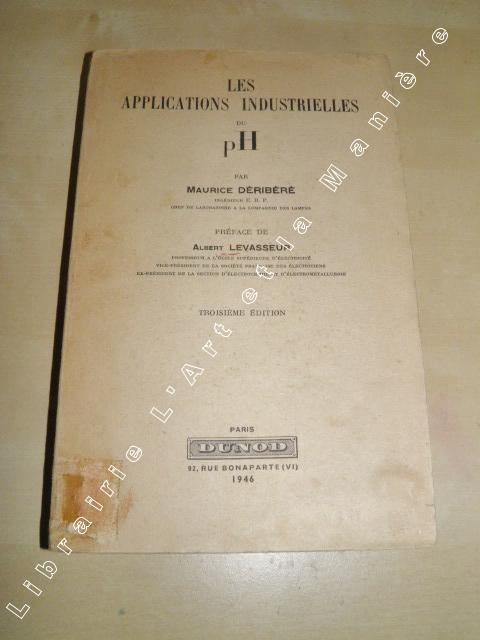
|
|
|
TIAN.
Notions fondamentales de chimie générale et de physico-chimie.
Paris Editions Masson et Cie. 1935 in-8 - 14x20cm Reliure d'époque en demi-chagrin noir, dos lisse, coiffes ornées de filets dorés, titre doré, tête verte. 316pp.
Bookseller reference : 182
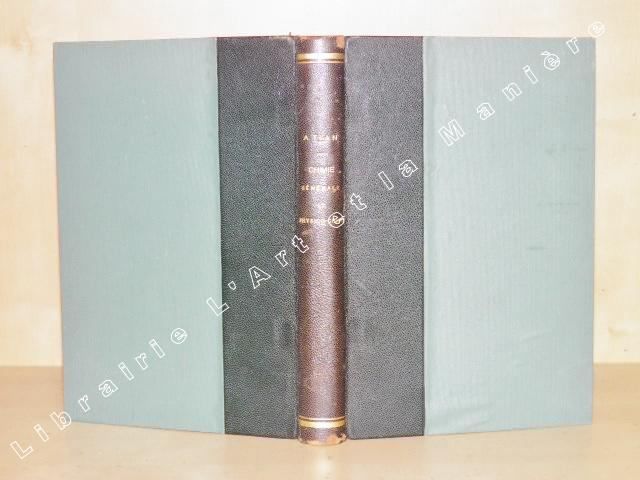
|
|
|
NAUD, Louis.
Cours élémentaire de sciences Physiques (Physique générale, électricité, chimie).
Paris Aux bureaux du Courrier des Examens. s.d. (circa 1920) in-8 - 13,5x22,5cm Broché. 111pp.
Bookseller reference : 191
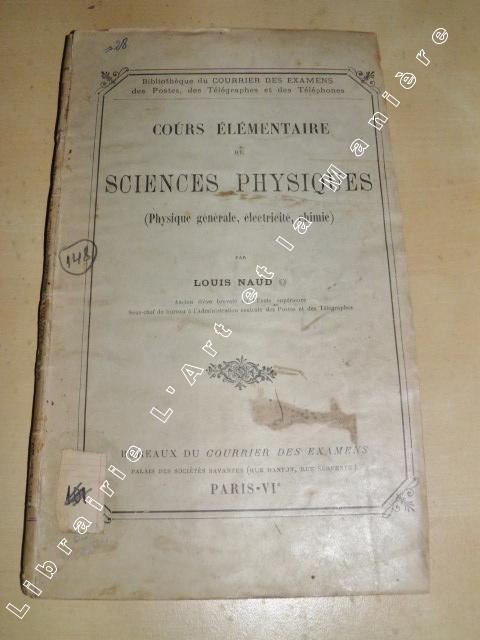
|
|
|
M. MAIGNE.
Arts et Manufactures. Exposition sommaire des méthodes et procédés de l'Industrie Contemporaine. Seconde partie : Métallurgie - Travail des Métaux - Industrie Métalliques - Produits Chimiques.
Paris Librairie Classique D'Eugène Belin 1876 Volume 2, seul, complet en lui-même. In-12 - 11,5x18cm. Reliure éditeur en pleine percaline verte, dos lisse orné de caissons à froid, encadrement de filets à froid sur les plats, tranches mouchetées. 2ff, 448pp, 2ff.
Bookseller reference : 774
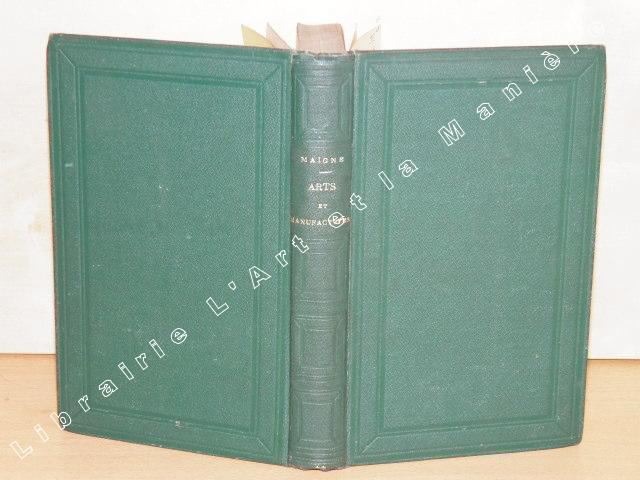
|
|
|
Ch.-Er. GUIGNET, F. DOMMER, E. GRANDMOUGIN.
Industries Textiles - Blanchiment et Apprêts. Teinture et Impression Matières Colorantes. Fibres textiles, végétales et animales. Blanchiment : coton, lin et jute, laine, soie. - Théorie de la teinture. Les Mordants : métalliques, organiques. Méthodes de teinture : tissus homogènes, tissus mixtes. Impression : tissus homogènes, tissus mixtes, articles specia X. Matières colorantes : minérales, organiques (artificielles, naturelles). Essais, Réactions. Etudes développée des nuances : simples, composées.
Paris Gauthier-Villars et Fils, Imprimeurs-Libraires de l'Ecole Polytechnique, du Bureau des Longitudes, Etc. 1895 In-8 - 16,5X24,5cm. Reliure d'époque en demi-chagrin brun, dos à 5 nerfs orné de filets à froid, initiales P.B. en queue, tranches mouchetées. 2ff, VIII, 1ff, 674pp, 1ff.
Bookseller reference : 840
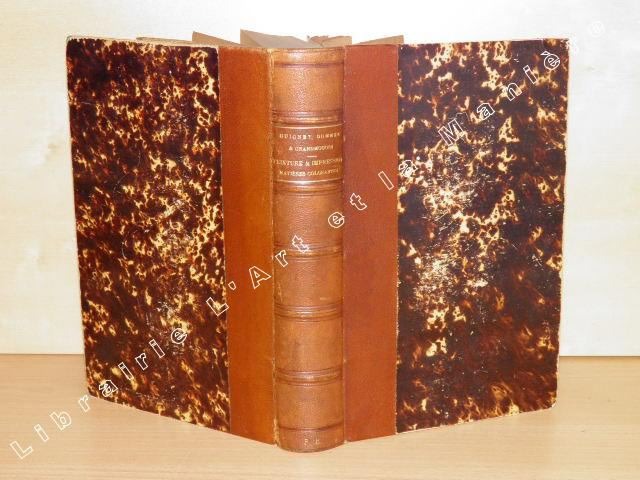
|
|
|
[CASSELLA, Léopold].
Tomo suplementario N°1 de nuestro tratado La Tintura del Algodon y de las fibras similares con los colorantes de Leopold Cassella & Cia, GmbH, Francfort s.M. Catalogue d'échantillons teintés.
Francfort sur le Main, Leopold Cassella et Cie. 1905. 16,5 x 25,5 cm. Cartonnage éditeur en percaline havane à coins, dos à faux nerfs décoratifs à froid, , filets, frises, titres et tomaisons dorés, nom de l'entreprise frappé à l'or en pied du plat supérieur. 191 pp. Ouvrage en espagnol, comportant en frontispice 3 reproductions photographiques des manufactures de Lyon (Manufacture lyonnaise de matières colorantes, "La Mouche"), Riga (couleurs d'aniline) et Francfort sur le Main ("Mainkur"), toutes dépendantes de la firme Leopold Cassella. Bien complet de 98 échantillons de coton teintés en divers coloris. Volume 1 seul, complet en lui-même, de supplément à un traité sur la Teinture du coton et des fibres similaires avec les colorants de la firme allemande L. Cassella. Ex-dono de Claude Gomar.
Bookseller reference : 1128
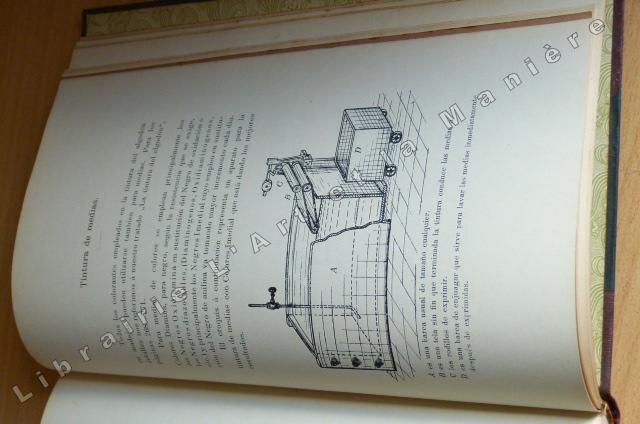
|
|
|
DEJEAN.
Traité des Odeurs, suite du traité de la distillation. Par M. Dejean, distillateur. [PARFUM - PARFUMERIE]
Paris, chez Bailly, Libraire, 1777. In-12 - 11 x 18cm. Broché, couvertures d'attente marrons, étiquette écrite à la plume encollée sur le dos. X-[2]-492 pages (complet). Complément indispensable (et beaucoup plus rare) du traité de la distillation du même auteur qui donne ici un très grand nombre de recettes de parfumerie ancienne. On trouve de nombreux ingrédients et recettes pour la beauté et la santé : eaux, lavande, fleur d'oranger, alcools parfumés, plantes aromatiques, huiles essentielles, lait virginal, laits pour peau, pour dissiper les taches et rousseurs, soins des mains, eaux cosmétiques, teintures, poudres, opiates pour les dents, pommades, essences pour les cheveux, pommades pour les lèvres, tablettes parfumées, pastilles à brûler, vinaigre d'odeur. La plupart des bibliographies affirment que Déjean est le pseudonyme d'Antoine Hornot, un distillateur parisien né à Nuits-Saint-Georges en Bourgogne. Oberle Fastes de Bacchus & Comus n°1087 - Vicaire p. 258 - Caillet 5259 (edit. de 1777 seulement) - Blake p. 221 - Wellcome II. 422 Ferchl 118.
Bookseller reference : 2631
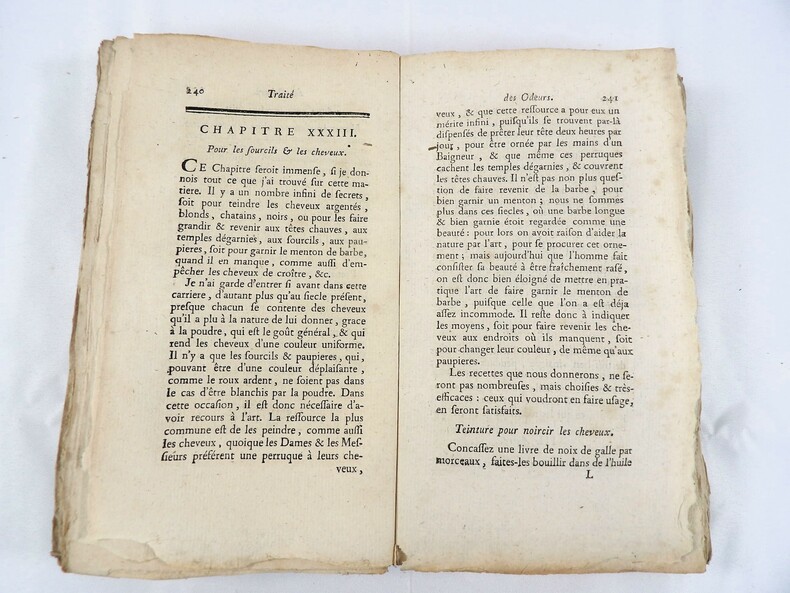
|
|
|
[CHIMIE] / PASCALIS (Georges)
La Protection de l'Argenture des Glaces par le cuivrage électrolytique.
S.l.n.d. (1913). Plaquette in-8° de 8 pp.[C37]
Bookseller reference : 2591
|
|
|
[CHIMIE] / EHRSAM (R.)
La Chimie du Savonnier et du Commerce des Corps gras.
Paris, Dunod, 1921. 1 vol. in-8° br. n. coupé, 378 pp.[C44]
Bookseller reference : 2594
|
|
|
[CHIMIE] / GURWITSCH (Leo)
Les bases scientifiques du traitement des huiles minérales.
Paris et Liège, Ch. Béranger, 1925. 1 vol. in-8° br., 519 pp.? FIG. dans le texte.[C39]
Bookseller reference : 2596
|
|
|
[CHIMIE] / MARCELET (Henri)
Les Huiles d'animaux marins. Procédés d'extraction. Analyse. Documents analytiques.
Paris et Liège, Béranger, 1924. 1 vol. in-8° br. n. coupé, couv. d'attente, 229 pp., fig. dans le texte.[C39]
Bookseller reference : 2598
|
|
|
[CHIMIE] / SAVARIT (P.)
Elements de distillation. Etude graphique des colonnes à distiller les mélanges binaires.
Paris, J. Loubat, 1923. Fascicule in-4° de 31 pp.[C37]
Bookseller reference : 2613
|
|
|
[CHIMIE] / FLEURY (R. de)
Technologie du caoutchouc souple.
Paris, Dunod, 1920. 1 vol. in-8° br. de 200 pp.[C39]*
Bookseller reference : 2627
|
|
|
[CHIMIE] / JACOBS (Fernand)
L'Industrie du Caoutchouc. Notions techniques, pratiques, scientifiques.
Paris et Liège, Béranger, 1923. 1 vol. in-8° br., couv. d'attente. 473 pp.[C38]*
Bookseller reference : 2740
|
|
|
[CHIMIE] / DULAC (Roger)
Fabrication des colles à froid industrielles.
Paris, Ed. techniques industr., 1935. 1 vol. in-8°, percaline bleue de l'éditeur, 296 pp.[C39]
Bookseller reference : 2742
|
|
|
[CHIMIE] / DULAC (Roger)
Fabrication des colles à froid industrielles.
Paris, Ed. techniques industr., 1935. 1 vol. in-8°, perc. marron éditeur, 296 pp. Second plat défraîchi (larges traces d'humidité). Bon état intérieur.[C44]
Bookseller reference : 2743
|
|
|
MARCHIS L
PRODUCTION ET UTILISATION DES GAZ PAUVRES.
Couverture rigide P , Dunod et Pinat , 1908 , grand in4° percaline verte éditeur , 320 pp , 30 taableaux, 235 figures. Un livre d ' actualité ! ! ! Traces d' humidité sur les plats n' affectant absolument pas l' ouvrage. Langue: Français
Bookseller reference : M13374
|
|
|
LAWRENCE SMITH (Prof. John, of Louisville).
Mineralogy and chemistry : Original researches.
1873 Louisville, KY. : Printed by John P. Morton and Company, 1873, 1 vol. in-8° (225 x 146 mm) reliure de lépoque 1/2 chagrin marron, dos à 4 nerfs, caissons ornés de fleurons dorés et encadré de doubles filets à froid, plats de papier marbré, de 401 pp.Coins émoussés, très bel exemplaire par ailleurs.
Bookseller reference : 12886
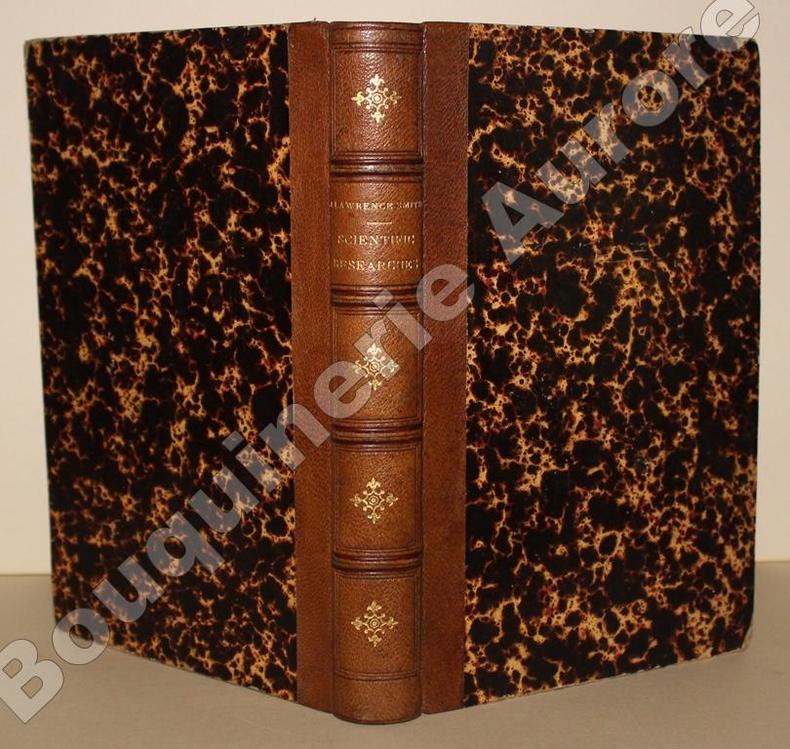
|
|
|
TIFFENEAU (Professeur)
Anniversaires : J. B. DUMAS 1800 - 1884.
Paris, Laboratoires Beytout, 1934, 18 X 25 cm., agrafé, 12 pp. Plaquette agrafée abondamment illustrée en noir. Publicité pour les produits du laboratoire Beytout sur l'intérieur des couvertures. En bon état.
Bookseller reference : 3742
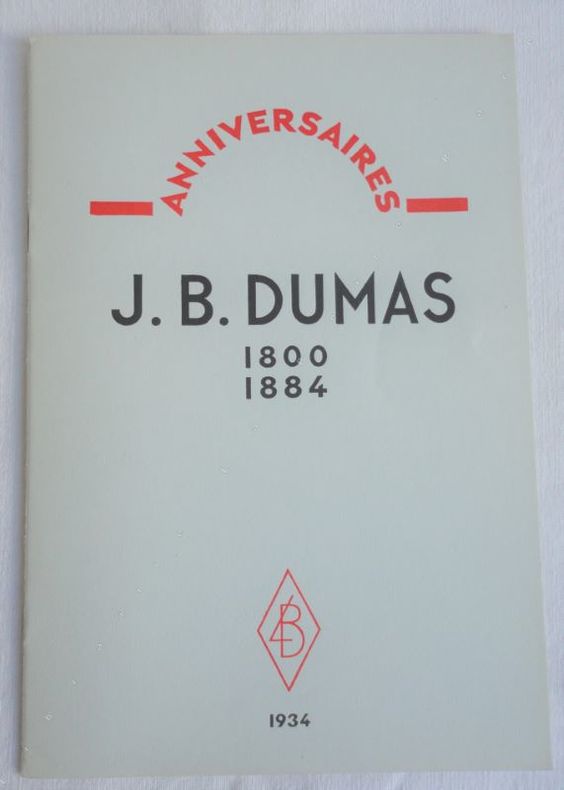
|
|
|
TARTRA (A. E.)
Traité de l'empoisonnement par l'acide nitrique.
Paris, Méquignon l'aîné, 1802, 13 X 20 cm., relié, 302 pages. Demi-veau à dos lisse, tranches jaspées. Des épidermures et des rousseurs éparses ; une page de frontispice probablement manquante.
Bookseller reference : 4147
|
|
|
DURVELLE (J.-P.).
Fabrication des essences et des parfums. Chimie des parfums.
Paris, Desforges, Girardot & Cie, 1930, 16 X 25 cm., relié, 807 pages. Avec 47 figures dans le texte et des tableaux. Troisième édition, entièrement refondue et mise à jour. Une table alphabétique très fournie complète l'ouvrage. Demi-toile à bandes à la Bradel, couvertures conservées. Coins émoussés, des petites traces sur la toile, cachet humide d'un précédent propriétaire sur la page de faux titre. En bon état néanmoins.
Bookseller reference : 4184
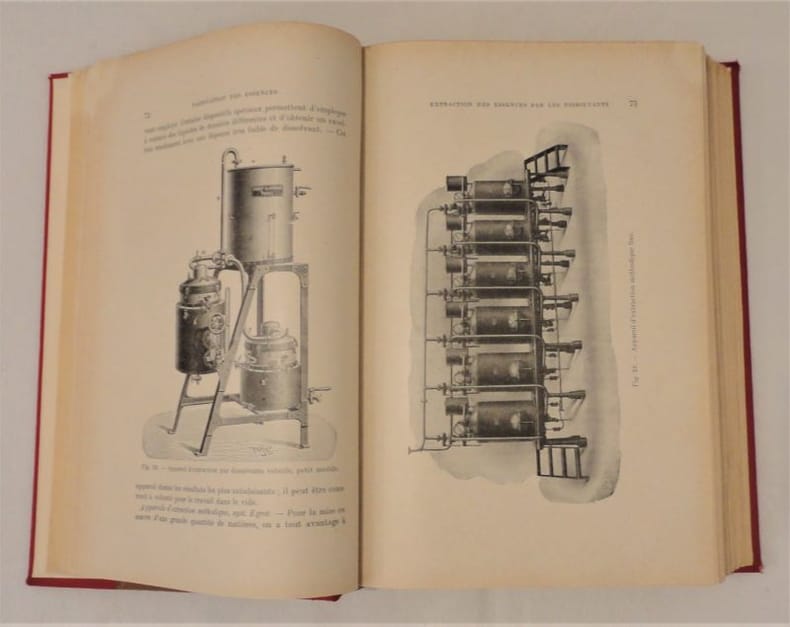
|
|
|
Arendt, Rudolf:
Lehrbuch der anorganischen Chemie nach den neuesten Ansichten der Wissenschaft auf rein experimenteller Grundlage. Für höhere Lehranstalten und zum Selbstunterricht. Enthaltend 291 Versuche.
Leipzig, Voss, 1868. 8°. XXXII, 507 S. Mit zahlr. Textillustr. Halblederband aus der Zeit.
Bookseller reference : 30422AB
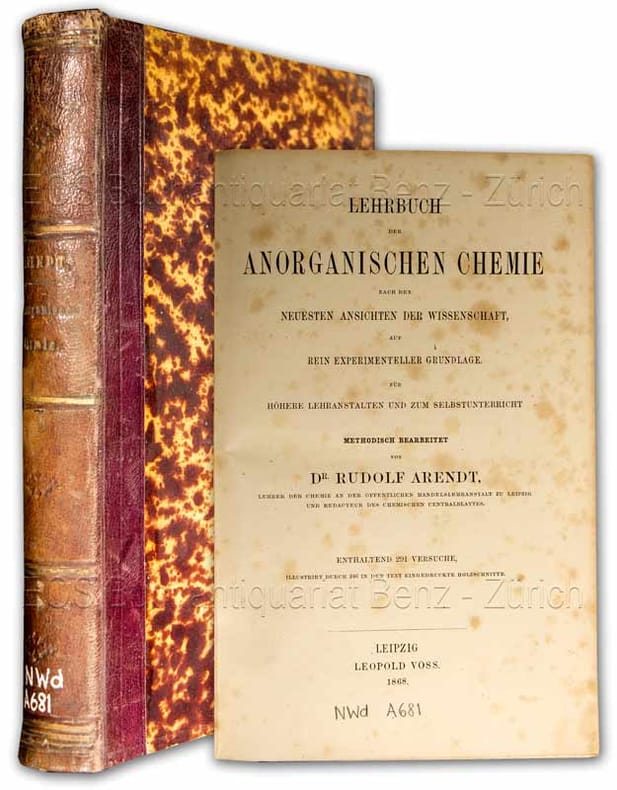
|
|
|
Becquerel, Antoine César:
Populäre Naturlehre. Mit besonderer Rücksicht auf die Chemie und verwandten Wissenschaften.
Neun Teile in 3 Bänden. Mit einigen, meist gefalteten Tafeln. Stuttgart, Scheible, Rieger & Sattler, 1845. 12°. Halbleinenbände mit Rückenbeschriftung.
Bookseller reference : 4770DB

|
|
|
Berzelius, Jöns Jacob:
Lehrbuch der Chemie. Aus der schwedischen Handschrift des Verfassers übersetzt von F. Woehler.
4. verbesserte Orig.-Aufl. (Band 3 in 3. Aufl. von 1834). 10 Bände. Dresden u. Leipzig, Arnold, 1835–1841. 8°. Mit 12 gef. Kupfertafeln und einigen Textillustr. Pappbände aus der Zeit mit roten Rückenschildchen (3. Band Halbleinenband nicht uniform).
Bookseller reference : 30452AB
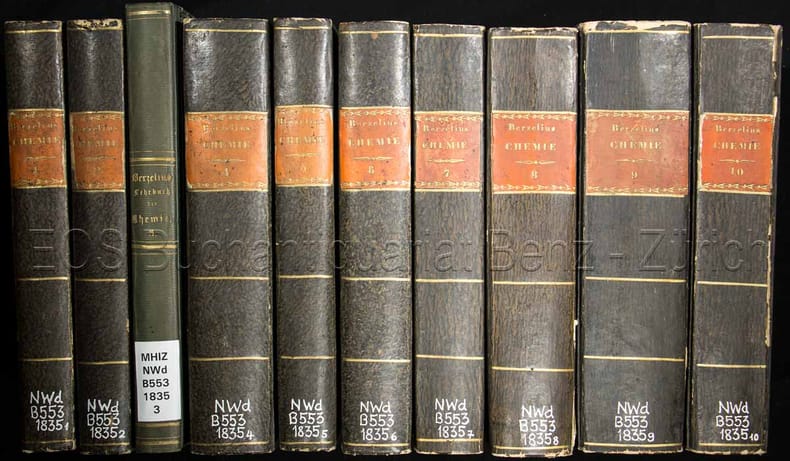
|
|
|
Goppelsröder, Friedrich:
Ueber die chemische Beschaffenheit von Basel's Grund-, Bach-, Fluss- & Quell-Wasser. Mit besonderer Berücksichtigung der sanitarischen Frage.
Basel, Schweighauserische Verlagsbuchhandlung, 1867. 8°. 97 S. Mit 9 Falttabellen. Pappband der Zeit (Rücken mit kleinen Rissen u. Materialverlust, berieben u. bestossen).
Bookseller reference : 22500AB
|
|
|
Hermbstaedt, Sigismund Friedrich:
Chemische Grundsätze der Kunst Branntwein zu brennen ... Nebst einer Anweisung zur Fabrikation der wichtigsten Liqueure.
2. (von 2) Band. Berlin, Carl Friedrich Amelang, 1823. 8°. VIII, 328 S. Mit 12 mehrf. gef. Kupfertafeln. Halblederband der Zeit.
Bookseller reference : 2582CB
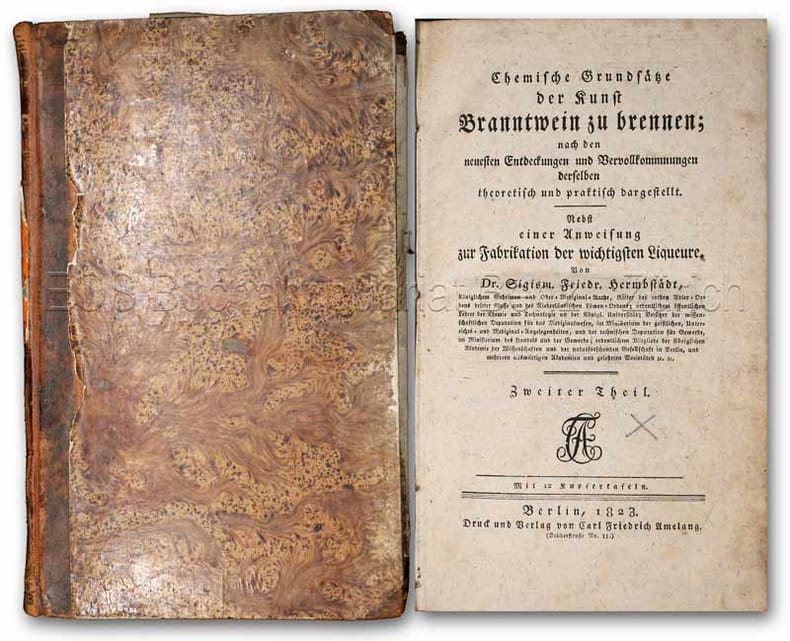
|
|
|
Karrer, Paul:
Lehrbuch der organischen Chemie.
2. Auflage. Leipzig, Georg Thieme, 1930. 8°. XXI, 889 Seiten Priv. Halbleinen mit Rückenbeschriftung (von Originaleinband).
Bookseller reference : 21047AB
|
|
|
Konvolut. – 4 Schriften zur Baumwollfärberei.
8° - gr.-8° Orig.-Brosch. bzw. Hefte.
Bookseller reference : 27006AB
|
|
|
Lavoisien, Jean-François:
Dictionnaire portatif de médecine, d'anatomie, de chirugie, de pharmacie, de chymie, d'histoire naturelle, de botanique et de physique. Qui contient les termes de chaque art, leur étymologie, leur définition & leur explication, tirés des meilleurs auteurs ...
Nouvelle édition, corrigée & augmentée. Paris, Théophile Barrois 1793. 8°. IV, 716 S. Halblederband der Zeit mit rotem goldgeprägtem Rückenschild und etwas Rückenvergoldung.
Bookseller reference : 35112DB
|
|
|
Otto, Friedrich Julius:
Die Essigfabrikation, die Zucker- und Stärke-Fabrikation, die Fabrikationd des Stärkegummis, Stärkesyrups und Stärkezuckers, sowie die Butter- und Käse-Bereitung für Chemiker, Landwirthe, Fabrikanten, Architekten, Jngenieure und Steuerbeamte.
4. Band, 2. Gruppe. Braunschweig, Vieweg, 1867. Gr.-8°. 578, 40 S. Mit zahlr. Textillustr. Pappband der Zeit.
Bookseller reference : 30486AB
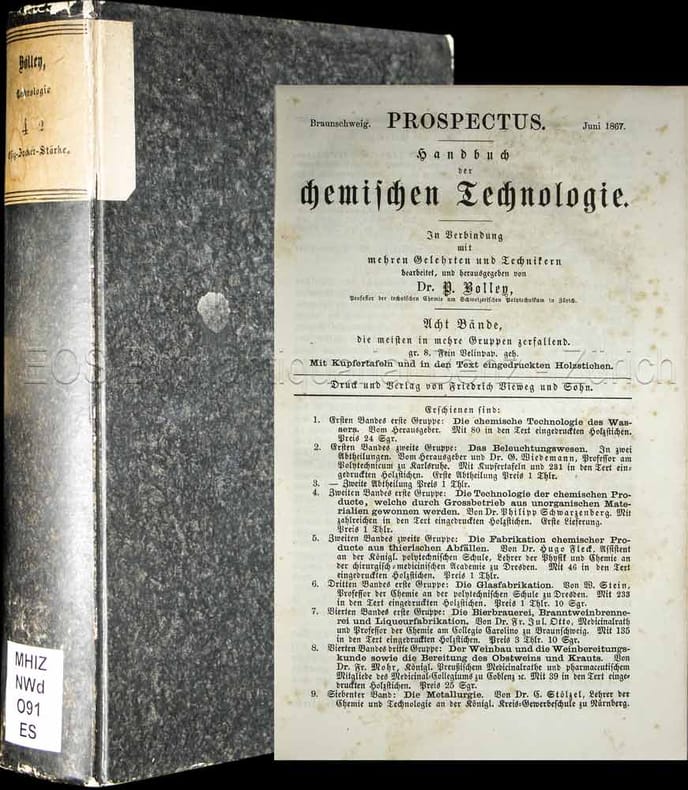
|
|